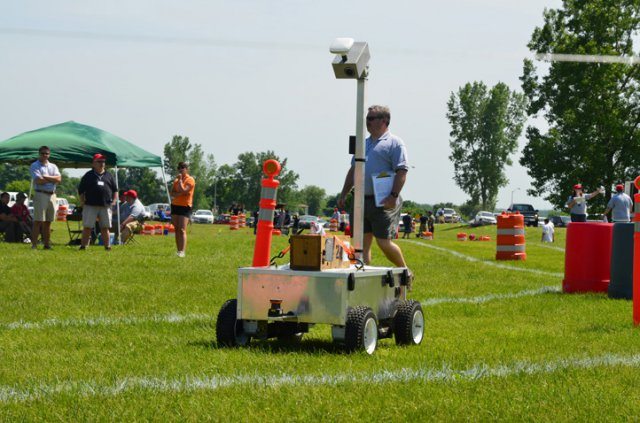On the battlefield, robots perform duties to help keep Soldiers out of harm’s way. Robots are taken to extreme environments and put through the paces navigating rubble-strewn roads and removing identified threats.
On a hot June day in Michigan, several robots simply tried to stay between two white lines on a grass field featuring uneven terrain and obstacles designed to present real-world navigational challenges for competing teams of programmers.
Forty teams from around the world converged June 3-6, on Oakland University’s campus in Rochester, Mich., for the 19th Annual Intelligent Ground Vehicle Competition, or IGVC, hosted by the U.S. Army Research, Development and Engineering Command’s tank and automotive center and the Association for Unmanned Vehicle Systems International. The culmination of many of the Army’s robotics education programs, IGVC allows future scientists and engineers the chance to get their hands dirty developing systems with real-world applications.
As part of its commitment to develop future scientists and engineers, the Tank Automotive Research, Development and Engineering Center’s Ground Vehicle Robotics team participates in outreach events for students of all ages, including Robofest for junior high school students and the FIRST (For Inspiration and Recognition of Science and Technology) Robotics Competition for high schoolers.
IGVC takes the lessons instilled from those events and pushes college students further, requiring them to design and build robots that must complete tasks similar to duties performed by military unmanned ground systems.
IGVC offers four unique events: Autonomous Challenge, Design Competition, Navigation Challenge and JAUS (Joint Architecture for Unmanned Systems) Challenge.
On the autonomous course, vehicles must stay between a pair of chalk lines and maneuver around obstacles. This year, organizers upped the ante, adding an off-road portion to the autonomous challenge.
“This is what we’re trying to accomplish in the real robotics world,” explained Jim Overholt, TARDEC senior research scientist for robotics. “We’ve also included a speed requirement, where teams must achieve a minimum speed before they’re allowed to run the course. Those features are indicative of what we need in the robotics community.”
Technology from this competition has spun off and influenced military robotics, Overholt noted.
“In addition to an outreach component, there’s deliverable hardware and software that we’re actually using now in the military community,” he explained. “We have probably seeded a large portion of the current commercial robotics industry with kids coming from these schools. They’ve gone on to robotics careers, and some have even started their own robotics companies.”
As teams went head-to-head on courses in Michigan, Soldiers on the other side of the world who encounter improvised explosive devices, or IEDs, benefit from the assistance of robots to safely complete their missions. Throughout the competition, organizers reminded students of the growing need for their skills.
“The IED remains the number one cause of current U.S. casualties. It is global, and it is viral,” remarked Navy Crd. Jack Downes, Joint IED Defeat Organization. “The application of this competition is very relevant to the future of our combat warriors. At JIEDDO, we’re pursuing technologies that will reduce the risk our warfighters face from IEDs, whether they are on the move in a heavy armored vehicle or on foot. The technology developed through efforts like this will be applied to defense solutions.”
In the field, warfighters have to work quickly to adapt to unforeseen challenges. Similarly, IGVC participants often returned to the pits or to the practice course to tweak systems when they stalled on the autonomous course or drifted outside the lines.
“We needed to modify our algorithm a little,” said Mike Scherer, University of Central Florida team leader. “When we first started, we were using a single [laser] beam of about two meters in front of the robot, but we kept getting stuck halfway through. So, we changed it to two beams that were each about 1.5 meters, which allowed the beams to curve around objects a little more and snake through the obstacles.”
“I love all of the hands-on experience,” Scherer continued. “Coming out here and working on these kinds of things has given us the opportunity to try out sensors that you don’t get to handle in class. It’s a fusion of so many disciplines. Our team has become a really tight-knit group and come together to produce this product.”
IGVC requires participants to focus on needs currently being experienced in theater, including system autonomy, enhanced navigation, common controls and improved vision. Conducting the competition outdoors presents a further challenge, as the weather’s unpredictability allows participants to better understand the way environment impacts operation.
“The biggest challenge has been vision and trying to get the camera to isolate white lines,” explained Robert Keyawa, team leader for California State University Northridge’s team, which took first place at this year’s IGVC. “Shadows cast over the lines don’t really hurt us, so if it’s overcast we don’t have an issue. The problem becomes the sun and the bright dead grass, which is all over the course. There was a patch at the first turn. That patch of grass keeps being seen as a white line, and we can’t figure out how to eliminate it completely.”
“My knowledge in mechanical engineering has definitely been increased,” he said. “Because of this project, I want to go into control systems. I want to design robotics and control them as best as possible.”
Downes urged students to keep their eyes on their objectives and noted that many technologies will have dual-use applications that both the military and industry can leverage.
“Continue to understand what task and mission you’re seeking to accomplish,” he concluded. “It’s not enough that your system be extremely intelligent and capable, but it has to integrate into the society that it is being built for, whether that society is a military formation or an agricultural concept or some other domestic purpose not yet envisioned.”










